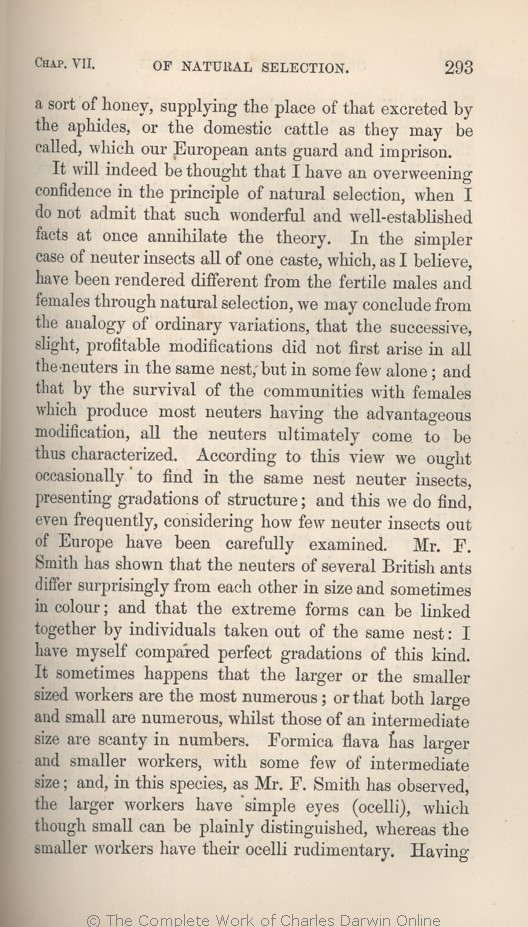It will indeed be thought that I have an overweening confidence in the principle of natural selection, when I do not admit that such wonderful and well-established facts at once annihilate
the | the 1869 1872 | | my 1859 1860 1861 1866 |
| caste, 1866 1869 1872 | | caste 1859 1860 1861 |
| which, as I believe, 1869 1872 |
| or of the same kind, which 1859 1860 1861 |
| which 1866 |
| different from the fertile males and females through 1869 1872 |
| by 1859 1860 1861 1866 |
| we may conclude 1869 1872 |
| as I believe to be quite possible, different 1859 1860 1861 1866 |
| OMIT 1869 1872 |
| fertile males and females,— in this case, we may safely conclude from the 1859 1860 |
| fertile males and females— in this case, we may safely conclude from the 1861 1866 |
| the 1869 1872 | | each 1859 1860 1861 1866 |
| modifications 1869 1872 | | modification 1859 1860 1861 1866 |
| first arise 1869 1872 |
| probably at first appear 1859 1860 1861 |
| at first appear 1866 |
| ..... 1869 1872 | | individual 1859 1860 1861 1866 |
| some 1869 1872 | | a 1859 1860 1861 1866 |
| survival 1869 1872 | | long-continued selection 1859 1860 1861 1866 |
| communities with females 1869 1872 |
| fertile parents 1859 1860 1861 1866 |
| produce 1869 | | produced 1859 1860 1861 1866 1872 |
| having 1869 1872 | | with 1859 1860 1861 1866 |
| advantageous 1869 1872 | | profitable 1859 1860 1861 1866 |
| come 1869 | | came 1859 1860 1861 1866 1872 |
| be thus 1869 1872 |
| have the desired 1859 1860 1861 1866 |
| characterized. 1869 | | character. 1859 1860 1861 1866 | | characterised. 1872 |
| According to 1869 1872 | | On 1859 1860 1861 1866 |
| in 1869 1872 |
| neuter-insects of 1859 1860 |
| neuter insects of 1861 1866 |
| nest neuter insects, 1869 1872 |
| species, in the same nest, 1859 1860 1861 1866 |
| frequently, 1866 1869 | | often, 1859 1860 1861 | | not rarely, 1872 |
| neuter insects 1861 1866 1869 1872 | | neuter-insects 1859 1860 |
| that 1869 1872 | | how surprisingly 1859 1860 1861 1866 |
| surprisingly from 1869 1872 | | from 1859 1860 1861 1866 |
| ..... 1869 1872 | | sometimes 1859 1860 1861 1866 |
| ..... 1869 1872 | | perfectly 1859 1860 1861 1866 |
| sometimes 1869 1872 | | often 1859 1860 1861 1866 |
| happens 1859 1860 1861 1869 1872 | | happen 1866 |
| whilst 1869 1872 | | with 1859 1860 1861 1866 |
| are scanty 1869 1872 | | scanty 1859 1860 1861 1866 |
| few of 1869 1872 | | of 1859 1860 1861 1866 |
|









